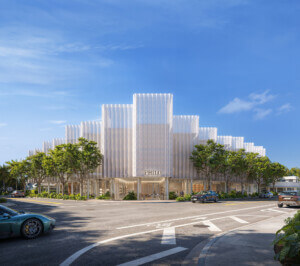Using aluminum casts that have been drilled to allow light to filter through, Japanese architect Kengo Kuma has created a tranquil space that is the Vanke Art Gallery.
Located in the Wuxi province, just West of Shanghai, the gallery’s amoeba-like footprint is derived from the shape of the local Taihu Lake stone that was once at the epicenter of Taihu culture in China. Kuma’s project also involved the renovation of a former cotton mill that is also part of the gallery complex.
The curvaceous aluminum-panelled facade wraps around the main structure, clad with glass, giving it a wide berth. These panels allow light to permeate through myriad gaps and gently illuminate the interior gallery. Because the facade was placed in front of the actual glass elevation, the effects of shadowing are exaggerated. Meanwhile, light is also allowed to reflect off water that bridges the gap between these two facades. In some places, this shallow pool of water’s footprint extends beyond that of the aluminum facade. As a result, three distinct footprints interplay, with the water acting as the initial threshold, of a series of three, between the public and private space.
The water, as the primary threshold, also establishes a calm and tranquil environment, something Kuma was eager to construct with the area’s history of being home to a bustling brick-built cotton mill. This is then reinforced via light filtering through and the choice of materiality.
Kuma, while disrupting the function within the immediate vicinity also instills a sense of tradition, drawing on the history of Lake Taihu, where the form of the Taihu stone comes from.
Wuxi Vanke Art which occupies a combined 112,375 square feet also offers spaces for commercial functions and offices within the two structures.










